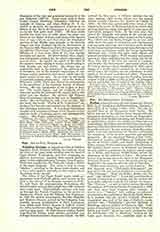

Pyrker, JOHANN LADISLAUS VON OBERWART (FELSOEOR), b. at Langh near Stuhlweissenburg, Hungary, November 2, 1772; d. at Vienna, December 2, 1847. He was descended from an old Hungarian noble family. His father was one of the eighteen brave hussars who distinguished themselves in the battle of Kunersdorf. Graduated from Stuhlweissenburg and Fuenfkirchen, he applied for a civil service position in Often, but was unsuccessful. In 1792 he entered the Cistercian chapter house at Lilienfeld, where he was ordained priest (1796). In quick succession he was steward, chancellor, prior, abbot, for a time, parish priest at Turnitz, and brought the monastery to the greatest material and spiritual prosperity. He was appointed Bishop of Zips (1818), Patriarch of Aquileia and Primate of Dalmatia with his see in Venice (1820), and finally Archbishop of Erlau, earning the love and veneration of his diocesans. He founded health resorts in Karisbad and Gastein for sick soldiers, a seminary for country school teachers at Erlau, and donated 10,000 florins toward the adornment of the cathedral at Erlau. His great collection of paintings forms the basis of the Hungarian National Museum. For these charitable gifts he was knighted by the emperor with the title of Felsö-Eor.
Pyrker wrote dramatic, epic, and lyric poetry. His first dramatic work, “Historische Schauspiele”, appeared in 1810, and contained three five-act tragedies: “Die Corvinen”, “Karl der Kleine, Konig von Ungarn”, and “Zrinis Tod”. It was not even considered worthy of discussion or criticism, and the various editions of his collected works do not contain the dramas. The “Tunisias”, an epic in twelve cantos, describing the conquest of Tunis by Charles V, appeared in 1820, and there have been frequent later editions. A sketch of a “Tunisias” with striking resemblances was found in the textbooks of the Jesuit Jacob Masen. It is possible that the Jesuit’s textbook (Palaestra eloquentiae) was used at the time of Pyrker’s youth. Another epic, “Rudolphias”, glorifies Rudolph of Hapsburg, and was printed in Vienna in 1824. Grillparzer dramatized the same material in his “Ottokars Gluck and Ende”, which has many similarities with the well-known “Ode to Hapsburg” written by the Latin poet Avancini, S.J., probably read in the schools at the end of the eighteenth century. Pyrker also wrote several short stories: “Die Perlen der heiligen Vorzeit” (1821); “Bilder aus dem Leben Jesu and der Apostel” and “Legenden der Heiligen auf alle Sonntage and Festtage des Jahres” (1842). As a lyric poet Pyrker published only a few mono-graphs, e.g. “Lilienfelds Freude”, and “Lieder der Sehnsucht nach den Alpen” (1845).
N. SCHEID

